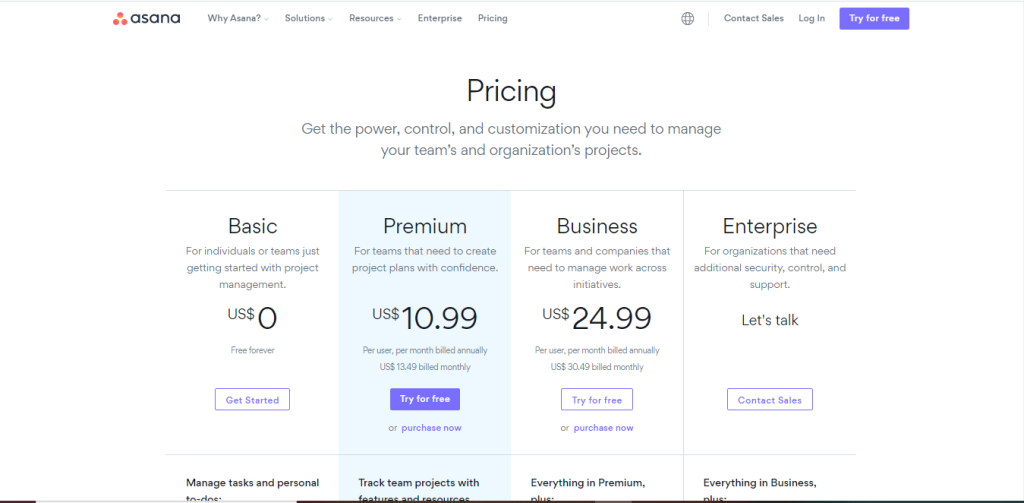If you are looking to buy project management software for your business, you probably have heard about Asana project management software.
Asana promotes its app heavily on social media and on Google Ads. The company has bottomless pockets since the funders came from Facebook.
The project management application space is extremely crowded. Competition is fierce and good for the consumer. The million-dollar question is if Asana is good for you and your business.
Asana Project Management Pros
Here we list the best features that Asana offers its customers.
Asana offers a free plan
Asana offers a free plan for organizations of up to 15 people. The free plan lacks many advanced features that are needed to manage a complex project.
For simple projects that need a simple to-do list, Asana is sufficient, but for large and complex projects, the free plan is not enough.
The user is forced to upgrade to expensive paid plans if they need a real project management application.
Integration with other applications
Asana does a good job of integrating with other applications. The application has integration with hundreds of apps like GSuite, Google Calendar, Slack, Dropbox, etc.
A few integrations like those with Google products are native, others you need to download the right plugin or use the Zapier workflow automation app.
Simple User Interface
For small projects, the user interface is simple and straight forward. The graphic design is good, and Asana uses cute gimmicks to make the application fun.
As projects get more complex and the number of project members increases, the user interface gets increasingly more crowded and harder to follow.
Features
Asana has a ton of features, but all the good ones are in paid plans. The free plan offers a simple to-do list and sufficient communication features.
Features that are absolutely needed for managing any project worth doing, like Timeline or Gantt Chart, dependency, a start date for tasks, and many more vital features are not available in the free plan Asana offers.
Asana Project Management Cons
Below we have covered a list of Asana project management cons for you.
Project view gets too complex
For simple projects Asana is OK, but for complex projects, it gets unruly fast. As the team’s size gets bigger, the Asana pages get more crowded and harder to navigate.
It is hard to track specific tasks or tasks for each member of the project and see their status. The project manager has a hard time getting a true picture of the project status and if there are roadblocks in finishing the project.
Task Limitations
Tasks can be assigned to just one person. This is sufficient for small projects. In large and complex projects assigning a task to multiple people is required.
In addition, very basic functions like start date and dependency are hidden under expensive paid plans offered by Asana.
Confusing Email Notification
Asana sends a ton of email notifications and the user can’t manage and customize notification’s timing and when it happens.
It is normal to get email notifications at odd hours of the day from Asana. Getting an email notification at 2:00 AM does not do anything to enhance productivity.
Limited Collaboration Features
Other than commenting and mentions, Asana lacks real collaboration functionality.
The app lacks a message board or a whiteboard. The user can’t collaborate on documents in the app either.
As an example, all communication in a task gets hidden when the task is completed. So if you need to go back and check the communication you had on a given task, it is very cumbersome to retrieve the chain of conversation that took place among team members.
Limited Document Collaboration
The user can leave comments on tasks and projects in Asana, but can’t do the same for documents. This hinders document collaboration.
Other project management apps provide markup tools so remote users can collaborate on documents.
Lacks offline mode
When the internet is out, so is Asana. An offline mode enables the user to work on the desktop offline until the internet service is restored.
Asana currently does not provide a desktop app or an offline option.
Slow to load
As the project gets bigger, the load time increases. This is even true for new projects. Sometimes during the day, the load time could be quite long.
A big percentage of complaints about Asana on social media and chat rooms has been due to the slow page load time of the application.
Cost
Asana is very expensive, and if you need advanced features, it gets even more expensive.
The cheapest plan confusingly called Premium plan costs $13.49 per user per month. The business plan costs you a cool $30.49 per user per month.
I don’t want to know how much they charge for the Enterprise plan (they don’t list the price for Enterprise plans).
If you need basic functions like Timeline/Gantt Chart, Milestone, and start date for tasks, you need to upgrade to the premium plan in Asana.
Premium plans lack third party integration and many other features.
If you need portfolios, workload, and approvals you need to upgrade to the Business plan.
If you need SAML (Security assertion Markup language), Data export, or decent customer support, you need to upgrade to the Enterprise plan while mortgaging your home.
No ability to block time for assignments
When you are assigning tasks to someone in Asana, you are completely blind to when they are free and when they are busy working on other tasks.
This is a huge problem since you need to manually correct the scheduling of your team members using the timeline.
Since the free version of Asana lacks a start date and duration and does not include the timeline, managing team resources on Asana’s free plan is impossible.
Export Options
Unless you buy Asana’s Enterprise version, Asana does not give you any export functionality.
In fact, in their privacy statement, they state clearly that all data entered in Asana by users belongs to Asana and not the customer.
Lack of prioritization
In Asana you can’t prioritize your tasks manually or any other way. This becomes a huge issue when you need to prioritize the work of your team members.
Due to the lack of ability to set priorities, the application is not suitable for large projects. You end up using email to set priority for your team which very much negates the need to use the Asana project management application.
Lack of view portfolio projects view
When managing large projects, it is absolutely necessary to see all tasks from all projects in one view, be it a list, calendar, or Kanban view.
Asana display tasks from one project at a time on all their pages.
Customer Support or lack of it
On social media, there are loads of complaints about Asana’s customer service. In most cases, Asana is slow to respond to customer issues for basic and Premium plans.
You need an Enterprise account to get decent customer care from Asana.
No Approval options
Limited Approval options are only available in Enterprise plans. If you have Basic, Premium, or business plans there are no approval options in the application.
No Task history
Task history is a tool that can help clarify issues related to task/project performance and how issues and risks were handled by management and employees.
The lack of task history hinders the post-mortem analysis of projects after they are finished.
For large and complex projects this analysis is the key to make future projects run better and more efficiently.
Admin Tools
Asana has very limited Admin tools for managers and admins to organize their projects and teams.
The lack of proper Admin tools within Asana is a big issue for large projects.
As an example, you can’t assign multiple admins for your workspace, or assign someone as a manager and others as team members.
reporting feature
In small projects, reporting is not an issue, but in large and complex projects, the project manager needs to report to higher-ups on a daily or weekly basis
The lack of proper reporting tools in asana project management forces the project manager to create these reports manually.
The problem with this is not only the project managers waste untold hours on creating the report, but the accuracy of these reports is also compromised.
From the time the report is created by the manager to the time the report is presented, the status of the project may have already changed.
Clarity on Tags
Tags in Asana are not organized well and could get messy really fast. This is especially true when more than one tag is used per item.
Lack of built-in time tracking
Asana lacks built-in time tracking. You can use third-party time tracking tools like Toggl etc.
The problem with using time tracking tools like all other third-party tools is the cost. You end up paying for Asana, Toggl, Dropbox, etc.
These costs add up and at the end of the month, your cost for managing your projects gets really high. Most small businesses and startups can’t afford these high charges.
Conclusion
If you have a small team or work on simple projects Asana project management free plan is sufficient for you.
If you work on large projects especially multi-disciplinary projects, then Asana is not the right tool for you.
A while back we did a review of Asana Alternatives and the best Asana Alternatives for 2020.
You can find better choices than Asana in an article we wrote named Better than Asana.
We have also done a review of the pros and cons for Monday and Wrike project management too.
Leave a comment below and let us know if we missed anything here about the Asana project management app. If you are presently using Asana and want to switch to Binfire, let us know. We give you a three months free plan and will help you to migrate to Binfire.

